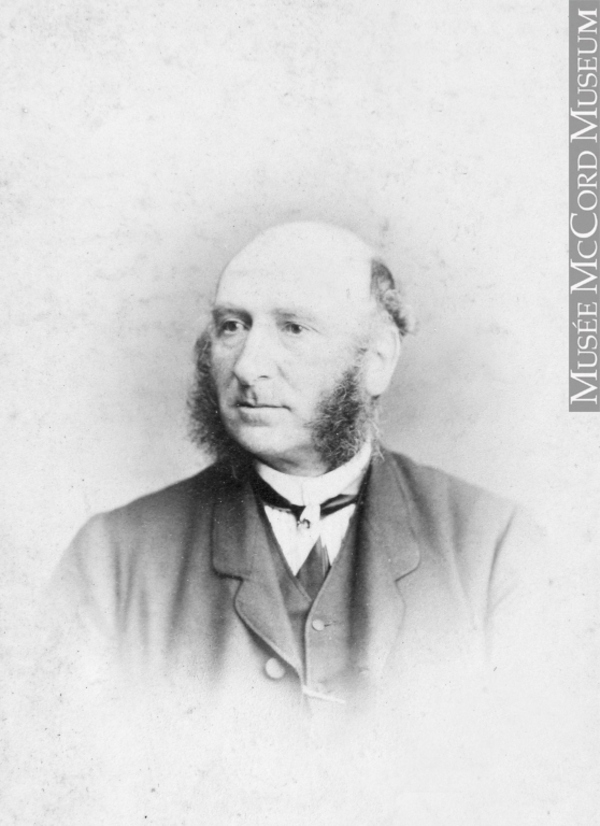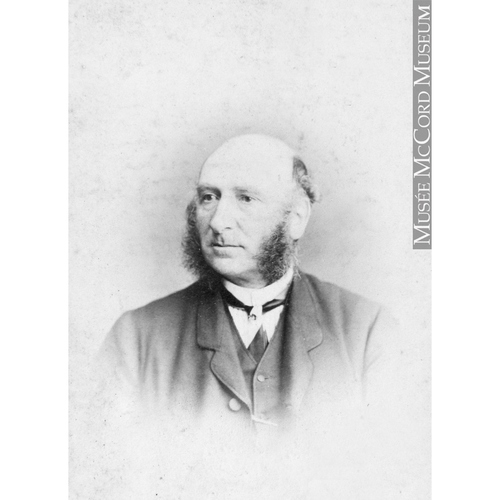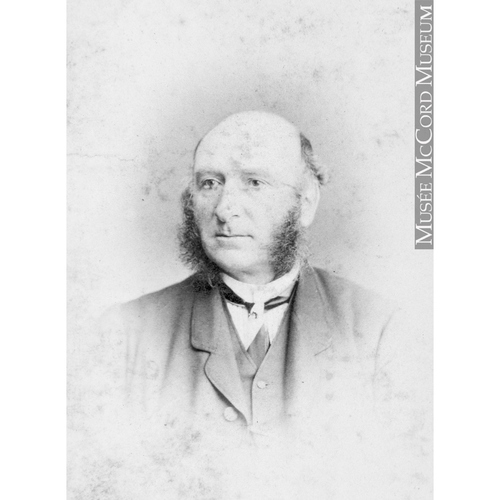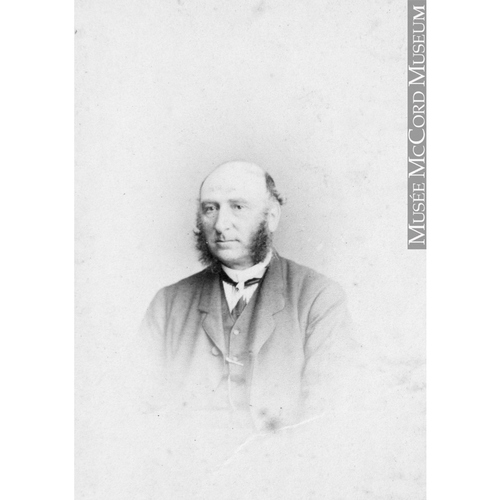
Source: Link
HENEKER, RICHARD WILLIAM, businessman and politician; b. 2 May 1823 in Dublin; m. 1856 Elizabeth Tuson in England, and they had three sons; d. 15 Aug. 1912 in Bournemouth, England.
Richard William Heneker received his formal education at the University College School in London, England. He apparently studied architecture privately and at age 19 entered the office of Charles Barry, architect of the Houses of Parliament at Westminster (London). He stayed with Barry until the late 1840s, at which time he set off on his own. He exhibited drawings on several occasions at the Royal Academy of Arts and in 1846 he won second prize in a competition for the design of a railway station. By the early 1850s he had been elected an associate of the Royal Institute of British Architects and had formed a partnership with Frederick Lawford, a fellow architect.
As late as 1854 Heneker and Lawford displayed designs at the Royal Academy. There was nothing to suggest that Heneker would soon embark upon a business career in Canada, nor is there any evidence to explain how an architect came to occupy a powerful role in the British American Land Company, the firm that controlled much of the land in the Eastern Townships of Lower Canada. The company had been founded in the 1830s by a group of men which included John Galt*. Galt’s son Alexander Tilloch* served as commissioner of the land company from 1844 to 1856. Based in Sherbrooke, the commissioner was the leading North American official of the company and, accordingly, one of the most powerful men in the Eastern Townships. By 1855 Galt wanted to devote himself fully to his political career and his personal business interests. He was persuaded to remain with the company for a year; Heneker was appointed assistant commissioner. On Galt’s resignation in 1856 the position of commissioner was open for Heneker, who would serve until 1902.
En route to Sherbrooke in 1855, Heneker had visited Lowell, Mass., presumably because he had been informed that lessons might be learned there which could prove useful in his new job. He was particularly struck by the way in which the various companies employing the same source of water-power were able to cooperate with one another. This cooperation, he observed, was made possible by the fact that “many persons hold shares in every one of the companies.” Ultimately, his business prominence in Sherbrooke was based upon his playing significant roles in various firms and it might be argued that he was able to get things done because of these numerous roles. In 1866, for instance, he used his position as commissioner of the land company and as the de facto owner of the major source of water-power in Sherbrooke to bring about the establishment of A. Paton and Company (renamed Paton Manufacturing Company of Sherbrooke in 1868), a woollen mill which would be the city’s most important employer throughout much of the late 19th century [see Andrew Paton*]. He served as the firm’s president until 1902. Similarly, he was among those who started the Eastern Townships Bank in 1859. By 1874 Heneker was the bank’s president, using his position to aid the woollen mill when it was in need. In addition, he served from 1892 to 1902 as president of the Sherbrooke Gas and Water Company, which had leased from the land company property bordering on the city’s major waterfalls. Heneker filled so many roles that when he appeared before the royal commission on the relations of labour and capital in 1888 he identified himself as “gentleman or banker, whichever you please. I have a variety of occupations, if I may so term it.”
This response did not endear Heneker to his superiors in the British American Land Company. Although he had presided over the reduction of the company’s property in Sherbrooke from 1,200 acres in 1857 to 607 in 1884, the directors in London were concerned by his preference for investing rather than selling. Accordingly, they curbed his ability to develop real estate and ordered him to concentrate on the liquidation of the company’s holdings.
Heneker was also involved in every significant activity of a social nature that touched on the English-speaking and Protestant population of the Eastern Townships. When he arrived there anglophones formed the majority in both Sherbrooke and the region which surrounded it, and he did all that he could to maintain the vitality of the English-speaking population. He was particularly active in the field of education through his close link to Bishop’s College, Lennoxville. He joined the college’s board of trustees in 1859, was made vice-chancellor and chairman of the board in 1875, and became chancellor in 1878, a position he would hold until 1900. He also involved himself in education at the provincial level, serving on the Protestant committee of the Council of Public Instruction as an associate (non-voting) member from 1876 to 1881, as a regular member from 1881 to 1900, and as chairman of the committee from 1892 to 1900. He acted in various capacities within the Church of England, particularly as a delegate to diocesan, provincial, and general synods, and he led the drive for the establishment of the Sherbrooke Protestant Hospital, serving as its first president from 1888 to 1902. He was active in various colonization societies which sought to bring English-speaking settlers to the townships.
This interest in advancing the concerns of the English-speaking population was also evident in Heneker’s limited political career. Although, campaigning as an independent Conservative, he lost the provincial seat of Sherbrooke to Joseph Gibb Robertson* in the election of 1867, he gained a measure of revenge by succeeding Robertson as mayor of Sherbrooke the following year. The mayor was chosen by the city council from among its members and Heneker, who sat on the council from 1867 to 1868 and again from 1876 to 1882, served another term in 1877. On the second occasion his election raised some concerns among French Canadians who remembered that the previous year he had protested that the French-speaking majority did not deserve a majority of seats on the council because they owned only one-quarter of the property in the city.
Across nearly 50 years, Heneker committed himself to two goals: the construction of a regional economy under local control and the maintenance of the influence of the English-speaking population. By the time of his departure from Canada in 1902, however, he had little reason to be pleased on either account. He and a small group of local businessmen had tried to pool their resources to establish an economy under their direction. They formed part of a regional bourgeoisie, but like members of this class elsewhere in late-19th-century Canada, they found their ambitions thwarted by the increasing concentration of influence over the economy in the hands of the grande bourgeoisie based in Montreal. Accordingly, Heneker saw the control of the woollen mill pass to Montreal interests dominated by George Stephen* and, although the Eastern Townships Bank remained locally owned until 1912, even in his own time Heneker could see the increased competition of the larger institutions eating into profits. Parallel to the decline of the local economy was the decline of the English-speaking population, which was decidedly in the minority by 1902. Thus, when Heneker retired to England, he was leaving an area that was quite different from the one he had tried to construct in his early decades in Canada.
Bishop’s Univ. Arch. and Special Coll. (Lennoxville, Que.), Corporation minutes; Trustees’ minutes. CIBC [Canadian Imperial Bank of Commerce] Arch. (Toronto), RG 4 (Eastern Townships Bank), board of directors, minutes. Cleyn and Tinker Company Arch. (Huntingdon, Que.), Paton Manufacturing Company papers. NA, MG 24, I54; MG 30, C128, 5. Can., Royal commission on the relations of labour and capital in Canada, Report (5v. in 6, Ottawa, 1889), 4, pt.2. Canadian men and women of the time (Morgan; 1898 and 1912). Algernon Graves, The Royal Academy of Arts . . . (8v., London, 1905–6; repr. in 4v., East Ardsley, Eng., 1970). J. I. Little, Nationalism, capitalism, and colonization in nineteenth-century Quebec: the upper St Francis District (Kingston, Ont., 1989); “Watching the frontier disappear: English-speaking reaction to French-Canadian colonization in the Eastern Townships, 1844–90,” JCS, 15 (1980–81), no.4: 93–111. Que., Parl., Sessional papers, 1890–1901, reports of the superintendent of public instruction, 1888–1900. Ronald Rudin, “The Megantic outlaw and his times: ethnic tensions in Quebec in the 1880s,” Canadian Ethnic Studies (Calgary), 18 (1986), no.1: 16–31; “Naissance et déclin d’une élite locale: la Banque des Cantons de l’Est, 1859–1912,” RHAF, 38 (1984–85): 165–79; “The transformation of the Eastern Townships of Richard William Heneker, 1855–1902,” JCS, 19 (1984–85), no.3: 32–49.
Cite This Article
Ronald Rudin, “HENEKER, RICHARD WILLIAM,” in Dictionary of Canadian Biography, vol. 14, University of Toronto/Université Laval, 2003–, accessed January 23, 2025, https://www.biographi.ca/en/bio/heneker_richard_william_14E.html.
The citation above shows the format for footnotes and endnotes according to the Chicago manual of style (16th edition). Information to be used in other citation formats:
| Permalink: | https://www.biographi.ca/en/bio/heneker_richard_william_14E.html |
| Author of Article: | Ronald Rudin |
| Title of Article: | HENEKER, RICHARD WILLIAM |
| Publication Name: | Dictionary of Canadian Biography, vol. 14 |
| Publisher: | University of Toronto/Université Laval |
| Year of revision: | 1998 |
| Access Date: | January 23, 2025 |





